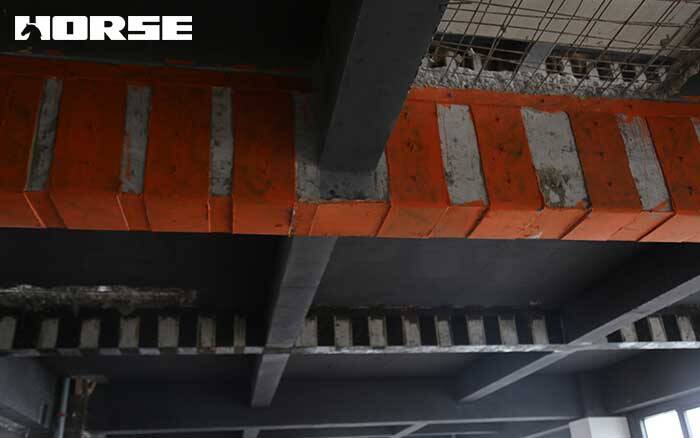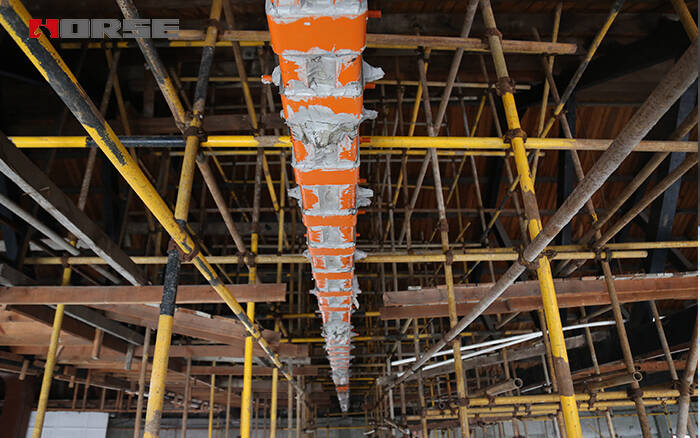Reinforced Concrete Beam Reinforcement
Steel Plate Reinforcement
In terms of design, the pasted steel plate reinforcement method can greatly improve the load performance of reinforced concrete members, and meet the requirements of increased load-bearing capacity of reinforced concrete structures. It is one of the preferred reinforcement methods for building structural reconstruction and reinforcement programs.

1 Project Overview
An office building has a four-story frame structure with an independent foundation. The height of the first floor is 4.8m, and the height of the second to fourth floors is 3.3m. The building area is about 1910m2. The office building is a new building. The original facade of the building is made of real stone paint, but now it is changed to dry hanging stone.
2 Reinforcement Design
2.1 Calculation analysis
The office building is a new structure, and the original building structure was not tested and identified before the renovation was put into use. The façade of the building is changed from real stone paint to dry hanging stone, and the structural load of the building changes. Based on the PKPM calculation model of the original building structure, the actual load on the external wall was applied, and the calculation was rechecked. Through the comparison and analysis of the calculation results of the software and the calculation results of the original building structure model, the original structure foundation bearing capacity and frame concrete column bearing capacity meet the requirements, and no reinforcement is required. The negative bending moment of the frame beam on some floors does not meet the requirements. If reinforcement measures are not taken, there will be a safety hazard to the structural safety of the office building.
2.2 Reinforcement scheme
Reinforced concrete beams are insufficiently reinforced at negative moments, and the reinforcement scheme is to increase the cross-section of the beam top and strengthen the beam top with steel. Reinforcement with enlarged cross-section at the top of the beam: cutting off the protective layer, planting reinforcement, tying reinforcement, supporting formwork, pouring concrete, and concrete curing, the construction period is longer. Reinforcement of beam top with steel: polished concrete surface of beam top, glued steel plate, fixed with chemical anchor bolts, steel plate surface protection, simple construction and short period. In order to shorten the construction period and reduce the cost at the same time, the reinforced concrete beam is reinforced with steel plate glued to the top of the beam.
The calculation shows that the top bonding steel reinforcement of the reinforced concrete beam adopts Q235B grade steel plate with a thickness of 5mm, which meets the requirements of the load-bearing capacity of the beam top.

3 Reinforcement Construction
3.1 Construction materials
Reinforced concrete beams are bonded with steel to strengthen the steel plates using Q235B steel, and the bonded steel structural adhesive uses A-level structural adhesive. The performance of steel should meet the following requirements:
1) The ratio of the measured value of the yield strength of the steel to the measured value of the tensile strength should not be greater than 0.85;
2) There should be an obvious yield step, and the elongation should not be less than 20%;
3) The steel should have good weldability and qualified impact resistance.
Adhesive for structural reinforcement (adhesive for pasting) adopts A-level structural adhesive, and its performance should meet the requirements of Article 4.2.2 of the national standard "Technical Specification for Safety Appraisal of Engineering Structure Reinforcement Materials" GB50728-2011.
3.2 Construction technical requirements
Office building reinforced concrete beam top bonding steel reinforcement construction operation process: concrete beam surface treatment-steel plate surface treatment-adhesive preparation-gluing and pasting-curing, chemical error detection and error solidification-inspection-anti-corrosion.
The implementation of sticking steel reinforcement is carried out in accordance with the "Code for Design of Reinforcement of Concrete Structures" GB50367-2013. The following aspects need to be paid attention to during the construction of beam sticking steel reinforcement.
1) When sticking steel plates are used to reinforce reinforced concrete structures, priority should be given to unloading the original structural members in addition to their own weight, and construction can only be carried out after unloading.
2) Before the reinforcement of the concrete beam, the surface stucco layer (or plaster layer) must be removed, oil stains, dirt, deteriorated layer, etc. must be removed, the larger depressions should be repaired with structural glue, and the surface dust must be removed and cleaned. After it is completely dry, wipe the surface with absorbent cotton moistened with acetone.
3) The bonding surface of the steel plate must be derusted and roughened. It can be polished with sandblasting, emery cloth or flat grinding wheel until metallic luster appears. The greater the roughness, the better. The grinding pattern should be perpendicular to the force direction of the steel plate. Wipe clean with absorbent cotton dipped in acetone.
4) The building structure glue is composed of two components A and B. Take a clean container and a weighing instrument to mix according to the instructions, and use a stirrer to stir for about 5-10 minutes until the color is uniform. It is best to mix in the same direction when mixing, try to avoid mixing with air to form bubbles, and the location should be well ventilated.
5) After the adhesive is prepared, apply a grease knife on the surface of the processed steel plate (or concrete surface). The section of the adhesive should be triangular, with a thickness of about 3mm in the middle and a thickness of about 1mm at the edge. Then stick the steel plate on the concrete surface, drill holes on the beam, and fix it with the prepared chemical anchor M12.
6) After pasting the steel plate, tap the steel plate along the pasting surface with a hand hammer. If there is no cavitation, it means that the pasting is dense, otherwise the steel plate should be peeled off and pasted again.
7) Anti-corrosion treatment, the surface of the steel plate should be brushed and sanded or hung with steel wire mesh and applied with high-strength cement mortar with a thickness of not less than 25mm as a protective layer.
4 Conclusion
In terms of design, the pasted steel plate reinforcement method can greatly improve the load performance of reinforced concrete members, and meet the requirements of increased load-bearing capacity of reinforced concrete structures. It is one of the preferred reinforcement methods for building structural reconstruction and reinforcement programs. In the construction of the stick-steel reinforcement method, the construction technology of stick-steel reinforcement should be fully disclosed before the construction, and the quality of the reinforcement construction should be strictly controlled during the construction process.